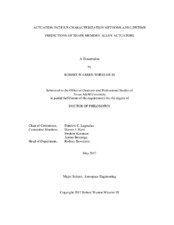| dc.description.abstract | Shape Memory Alloys (SMAs) are a class of intermetallic alloys that possess the ability to repeatedly sustain large amounts of deformation and recover a designed geometry through a thermal-induced, diffusionless, solid-to-solid phase transformation. Due to their high actuation energy density and ability to recover large strains, SMAs have many promising engineering applications in the aerospace, automotive, biomedical, and energy industries. In recent years, the interest in high temperature SMAs (HTSMAs) has increased dramatically due to their potential applications in harsh environments, such as those commonly seen in the aerospace industry. However, the lack of standard testing methods which accurately characterize and model thermomechanical fatigue in SMA actuators frequently limits their use to non-structural/non-critical components or results in actuators being severely overdesigned.
While many actuation fatigue studies have been completed over the last three decades, the vast majority have only considered isobaric loading paths with full or partial degrees of transformation. However, many potential applications, such as morphing aerostructures or deployable space structures, require more complex thermomechanical loading paths. In order for SMAs to be used in such applications, existing testing standards and actuation fatigue lifetime prediction methods must be improved.
The four objectives of this study are: First, the fatigue behavior of equiatomic NiTi is investigated in order to develop methods for studying actuation fatigue and provide a baseline actuation fatigue response for constant force biasing loads. Second, the actuation fatigue behavior of equiatomic Nickel-Titanium and the HTSMA Ni50.3Ti29.7Hf20 is studied to create a fatigue database for the purpose of actuator design. Third, improved testing and data collection methods and processes are developed for characterizing the actuation fatigue response of SMAs for complex thermomechanical loading paths. Fourth, the axial actuation fatigue data collected and the provided torsional fatigue data are utilized to analyze and evaluate the capabilities of the previously proposed actuation fatigue lifetime predictions. These actuation fatigue lifetime prediction methods are modified, as needed, to account for minor loops and variable loading conditions. This research will enhance future testing methods and understanding of actuation fatigue and improve the design of SMA-based solid state actuator systems. | en |


